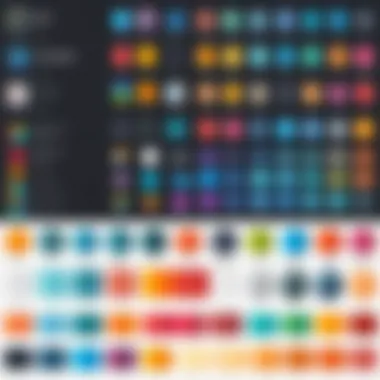Mastering Logo Design with Inkscape: A Comprehensive Guide


Intro
Logo design is a crucial facet of branding and identification. Developing a unique logo can set businesses apart in a crowded market. Using the right tools can make this task easier and more effective. Inkscape is an open-source vector graphics editor, and it offers various capabilities perfect for logo design. This guide aims to provide a detailed examination of Inkscape for this specific purpose.
Industry Overview
In recent years, there has been a marked increase in the interest surrounding vector graphic software. This trend aligns with the broader movement toward digitization and visual communication. Advanced features in software, such as Live Preview and various export options, aid designers in fulfilling demanding client criteria. Additionally, generational shifts in consumer behavior bolster the demand for fresh, tailormade logos.
Current Trends in the Industry-specific Software Market
The graphic design software market has seen a rise in tools that emphasize user-friendliness and accessibility. This is largely due to the fact that non-professional users wish to take a more active role in their branding. Many prefer open-source solutions like Inkscape because they can be accessed without financial attainment barriers.
Key Challenges Faced by Buyers in the Industry
Despite the numerous options available, buyers often face obstacles. The vast array of features can be intimidating. Understanding which tools best fit their needs can be hard. Most often, buyers get stuck comparing functions instead of assessing how the software aligns with their project goals.
Emerging Technologies Impacting the Industry
Automation and artificial intelligence are changing the landscape of design software. Many tools now integrate AI for noise reduction, image generation, and enhanced capabilities. Inkscape is no exception. It now includes plugins that can help speed up certain processes in the logo design propess.
Understanding Logo Design
Understanding logo design is a foundation for creating strong visual identities. In this section, we will explore various aspects that are essential for comprehending the significance of logos in branding. Logo design is more than just aesthetics; it is about crafting a visual symbol that embodies the values and essence of a brand. By grasping these elements, one can ascertain the role of effective logos in the broader context of marketing and communication.
The Role of Logos in Branding
Logos serve as the first impression of a brand. They are visual representations that can evoke emotions and communicate messages. The effectiveness of logos in branding is recognized across industries. For businesses large and small, logos create an instant connection point with customers, allowing for brand recall and recognition over time.
Qualities of a strong logo include:
- Memorability: A well-designed logo is memorable, allowing customers to recall it easily.
- Professionalism: Logos convey a sense of professionalism, enhancing credibility in the eyes of customers.
- Emotional Connection: Good logos can evoke emotions, building stronger relationships with audiences.
Why Choose Inkscape for Logo Design
In the era of digital creativity, the choice of tools can profoundly influence the outcome of your design project. Inkscape stands out for logo design due to its unique capabilities and its position as a powerful open-source alternative. Choosing the right software like Inkscape ensures that one can make professional-grade logos without the constraints of proprietary software like Adobe Illustrator. This section unfolds how this tool contributes significantly to educational experiences in design while maintaining accessibility.
Preface to Inkscape
Inkscape is a vector graphics editor that provides users with a platform to create and edit scalable vector graphics (SVG) easily. Developed as an open-source project, Inkscape attracts both beginners and seasoned graphic designers alike, helping to bridge the gap in technical expertise.
Working with Inkscape means engaging in a design process rooted in precision. It allows for full control of curves and shapes with tools like the Bezier pencil and calligraphy tool. The UI is optimized for creating visually engaging designs and logos that adapt well across different platforms and mediums. Inertia easing in loading and tool response merits special mention, ensuring one can concentrate on their creative endeavors without unnecessary distractions from the software itself.
Advantages of Using Inkscape
Inkscape brings forth various advantages which make it suitable for logo design:
- Cost-Free: As a free tool, it eliminates financial barriers, especially for startups or individuals just venturing into business.
- Scalability: Logos must be visually consistent across varying sizes. Being a vector editor, it allows scaling without loss of quality.
- Strong Community Support: With a large online community, users benefit from shared resources, tutorials, and extensions which enhance functionalities.
- Cross-Platform Compatibility: It works on Windows, macOS, and Linux systems, ensuring accessibility for a broader audience.
This flexibility leads to an empowering sense of ownership over one’s design work, making users fluent in using creative assets fluently across various projects.
Comparing Inkscape with Other Design Tools
When comparing Inkscape to other design tools like Adobe Illustrator, CorelDRAW, or Affinity Designer, a few notable distinctions emerge.
- Licensing: Illustrator and other proprietary tools require licensing fees, which can become quite costly. Inkscape's open-source license allows both personal and commercial use free of charge.
- Complexity: While tools like Adobe Illustrator offer comprehensive features, the learning curve can be steep for newcomers. Inkscape offers a good balance of powerful features presented in a more user-friendly manner.
- Integration: Many users find Inkscape easily integrable with other software like GIMP for bitmap editing, creating a robust environment for diverse design needs.
Inkscape serves not only as a practical tool for designing logos but also as a platform that promotes design literacy in the digital age.
Getting Started with Inkscape
Getting started with Inkscape is a crucial step for anyone interested in logo design. It sets the foundation for how effectively you can use the software to bring your design ideas to life. Gaining familiarity with Inkscape not only aids in streamlining workflows, but it also opens the door to advanced features and capabilities that can enhance your design projects.
Installing Inkscape
Installing Inkscape is the first milestone towards exploring the capabilities of vector graphic design. Inkscape can be downloaded from its official website, offering installation options compatible with Windows, macOS, and Linux. Follow these simple steps to get started:


- Visit the Inkscape website and navigate to the download section.
- Choose the appropriate version for your operating system.
- Follow the setup instructions provided for your OS.
- Once the installation is complete, launch the application.
Once installed, ensure that you have the latest version, as updates bring enhancements and fix bugs that improve stability.
Navigating the User Interface
An understanding of the user interface is vital for efficient use of Inkscape. The layout may seem cluttered at the start, but you'll find that it is organized intuitively.
The primary components of the Inkscape interface include:
- Toolbox: Located on the left side, this contains the essential drawing and editing tools you need.
- Canvas: This is the main area where you will create your designs. It allows you free space to work.
- Menu Bar: This at the top offers access to advanced features, organizational tools, and options.
- Status Bar: Shows useful information like your cursor position and selected tool settings.
- Palettes: Found on the right, here you manage fill and stroke styles, layers, and objects.
Familiarizing yourself with these elements lays the groundwork for informed usage of the software.
Understanding Tools and Features
Inkscape is equipped with a variety of tools, each serving a unique purpose in the logo design process. Understanding these tools is essential:
- Selection Tool: Selection from multiple objects. Great for positioning elements.
- Draw Bezier Tool: Allows for free-form paths, essential for custom shapes and logos.
- Text Tool: Lets you add typographic elements. A plethora of font styles can be incorporated here.
- Path Editing Tools: To manipulate, convert, and edit vector paths for sophisticated designs.
Additionally, getting familiar with fundamental features like layers, grouping objects, and saving in different formats will greatly enhance your workflow. Mastery of these basic tools significantly boosts your efficiency as a designer.
Quote: Understanding these initial components is key to unlocking Inkscape’s powerful design features. The better you know the tools, the smoother your design journey will be.
Designing a Logo Step by Step
In creating a memorable logo, the journey often begins with a clear organizational structure kent in mind. Designing a logo step by step is crucial because it ensures a methodical approach, allowing for creativity while minimizing oversights and inconsistencies. This targeted framework assists in imbuing the logo with meaning that aligns well with the brand's identity. By following this structured process, you can significantly enhance the effectiveness of the logo and cater to your audience's expectations.
Defining Your Brand Identity
Defining the brand identity serves as a cornerstone for the design process. It begins by understanding the unique qualities and core values that a brand embodies. This step is essential, as the brand's psychology shapes its visual presence in the market. When you articulate your brand's mission, values and differentiators, you create a detailed context in which your logo will live.
Key considerations include:
- Target Audience: Who are they? Knowing your audience impacts visuals.
- Brand Values: What does your brand stand for? Articulating these creates a relatable design.
- Industry Standards: How is your industry visualized? Understanding norms enables you to innovate within a framework.
Once you have answers to these queries, they will guide the visual aspects of your design. Your logo should resonate well and communicate the essence of your brand clearly.
Sketching Your Ideas
Sketching is an integral part of logo design, allowing fluid expression of creativity without the constraints of software. During this phase, ideas can manifest through paper or digital means. The goal here is to translate definitional characteristics of your business into shapes, forms, and letters.
Ideas should not rub against each other but instead lead to several iterations of thoughts, presenting patterns and inspirations. Make use of elements like:
- Circles for unity and connectivity.
- Squares for stability and professionalism.
- Curves for elegance,
Do not hesitate to sketch freely. This gathering phase sparks creativity, leading to potential elements worthy of exploring in a digital design.
Creating a Digital Version in Inkscape
Once sketches are complete, the next logical step is bringing these ideas to life digitally using Inkscape. With this software, creating a scalable vector logo can be very practical. This is because vector graphics retain quality on various scales, thus necessary for logos.
Follow these high-level steps:
- Start with a fresh canvas where your sketches can be uploaded.
- Use Inkscape tools like the Bezier Tool and Pen Tool to trace or create your logo.
- Utilize the Fill and Stroke option to add colors and outlines that signify your brand identity.
- Constantly zoom in and out to assess details and overall balance of the logo.
During this process, leverage features like layers to alleviate confusion and organization, ensuring each element aligns harmoniously.
Exporting Your Logo
Finalizing your design mandates knowledge concerning how to export in various formats. Exporting is foundational in ensuring accessibility across platforms for branding essentials such as social media, websites and printed materials.
Here are some commonly required formats:
- SVG: Retain the advantages of vector graphics while providing scalability.
- PNG: Great for web usage, preserving transparency.
- PDF: For print-friendly versions, ensuring resolution is high.


After you export, continually check how the logo performs in different applications and formats. This comprehensive evaluation gives a deeper understanding of the logo's adaptability before launch. By fine-tuning this crucial end step, you secure the integrity, appearance, and functionality of your crafted logo.
Successful logo design necessitates an appreciation for each part of the process. Attention to brand identity, sketching, digital creation, and exporting lays a strong foundation for impactful logos.
Best Practices for Logo Design
In the realm of logo design, adherence to best practices is crucial. These principles govern the creation of visually appealing and effective logos. A well-designed logo acts as a key pillar in a brand's identity and presentation. By following effective strategies, designers ensure their logos not only stand out but also convey the essence of the brand. This section will focus on the elements that contribute to strong logo design, discussing simplicity, color applications, and typography considerations.
Simplicity and Versatility
Simplicity forms the foundation of effective logo design. A simple logo is often more memorable and easier to recognize. It should be designed to create an immediate impact without overwhelming the viewer. The principle of simplicity extends beyond aesthetics; it influences the functionality of the logo. A complex design may not scale well across diverse applications, leading to decreased visibility and recognition.
Versatility works hand in hand with simplicity. Designers should ensure that a logo works well in various environments, whether printed or displayed digitally. A versatile logo maintains its integrity across different sizes, contexts, and backgrounds. If it looks as great on a small business card as it does on a large billboard, its versatility is a success.
Key Considerations for Simplicity and Versatility:
- Ensure clarity by avoiding small details that may get lost when scaled down.
- Test the logo in various sizes and formats to confirm its effectiveness.
- Opt for limited color palettes that maintain coherence.
Color Theory Applications
Color influences perception. Understanding color theory is essential for creating an effective logo that resonates with the target audience. Each color communicates different emotions and associations, making it a critical component of the design process. The choice of color should match the brand's personality and the message that needs to be conveyed.
For instance, blue often symbolizes trust and professionalism, suitable for financial institutions or healthcare. On the other hand, vibrant colors may communicate energy, appealing for youth-oriented brands. When applying color, one must also consider color harmonies and combinations to create a visually compelling design. Avoid excessive colors which can dilute the message.
Popular Color Associations:
- Red: Passion, excitement; good for brands focusing on food or entertainment.
- Green: Growth, freshness; ideal for nature-related businesses.
- Black: Sophistication, elegance; preferred for luxury brands.
Typography Considerations
The choice and arrangement of typography is imperative to logo design. Typography influences how the brand name is perceived and ensures readability. Selecting the right font requires not only attention to style but also functionality. A readable logo allows the brand name to be easily understood, even at a glance.
Different typefaces carry distinct actions. Serif fonts can evoke tradition and reliability, while sans-serif fonts lend a modern and clean feeling. The typographic choice should align with the overall identity of the brand and the accompanying designs. Avoid overly decorative fonts which may hinder readability, especially at smaller sizes.
Important Typography Criteria:
- Readability across different media and sizes.
- Alignment with brand identity and target audience.
- Balance between typography and other graphical elements.
Applying simple yet effective strategies in logo design ensures meaningful representation of the brand while promoting recognition and memorability.
Common Challenges in Logo Design
When delving into logo design, grappling with various challenges is almost inevitable. Recognizing these common hurdles can make all the difference in ensuring a logo's success. Understand that each challenge not only tests a designer's skill but also shapes the final outcome.
Avoiding Over-Complexity
Complexity can be a double-edged sword in logo design. A common mistake is overloading a logo with unnecessary details, which can confuse, rather than communicate. Keeping designs clean and simple often results in better recall and greater versatility.
Here are some aspects to keep in mind when avoiding complexity:
- Focus on core elements: Prioritize the main ideas or symbols that represent your brand or idea.
- Limit colors: Use a restrained color palette to maintain clarity.
- Avoid excessive typography: Stick to one or two fonts to create a more uniform appearance.
Ultimately, a straightforward logo is easier to recognize and more impactful. Designers should continually ask themselves, "Does this element contribute anything to the overall message?" If it does not, it may be worth reconsidering its presence.
Misalignment with Brand Values
Having a logo that reflects your brand values is crucial. A logo that fails to express the true essence of a company signals confusion. An effective logo should resonate with the target audience and align closely with the brand identity.
To ensure alignment, consider the following:
- Brand voice exploration: Understand how the logo fits within the larger narrative of your brand's voice.
- Target audience awareness: Different demographics react to symbols and styles differently. Your design should speak to the intended audience.
- Feedback loops: Use feedback from stakeholders to ascertain if the logo message aligns with brand goals.
Taking time to align a logo with brand values is time well spent, ensuring clarity and trust when communicating with the audience.
Ignoring Scalability


A logo needs to remain effective across different sizes and mediums. Ignoring scalability can result in a logo that works well on a business card but becomes unrecognizable on a billboard. This inconsistency can weaken a brand's presence.
Key points to consider when focusing on scalability include:
- Responsive design principles: Create a logo that can adapt to a variety of applications, from small icons to large signages.
- Vector formats: Utilize vector graphics in tools like Inkscape for crisp results across different sizes.
- Revisions for size tests: Conduct size variations during the design process to see how the logo holds up in different dimensions.
Advanced Techniques in Inkscape
Advanced techniques in Inkscape are critical for those looking to elevate their logo design skills. Understanding and effectively leveraging these methods allows designers to produce more refined and professional logos. Such techniques can enhance creativity, enabling one to convert unique ideas into visually compelling graphics. Mastery of these tools can also save time, helping artists to work more efficiently.
Using Layers Effectively
One of the most powerful features in Inkscape is its layering capability. Layers provide a dynamic way to organize and edit design elements within a logo project. Each layer acts like a transparent sheet that can hold graphical objects. This makes fae handling different components simpler, enables easy adjustments, and improves the overall workflow.
Here are some critical points to remember when using layers:
- Organize components logically: Establish a clear structure for your layers. You might have separate layers for text, shapes, and colors. This helps in avoiding confusion during the editing process.
- Utilize grouping within layers: Group related objects within layers. This permits easy manipulation of multiple elements in one go, simplifying transformations.
- Use layer opacity: Play with transparency to create depth effects in your design without cluttering other elements.
By treating layers as distinct elements of your design rather than a clump of graphics, you can maximize efficiency.
Creating Custom Shapes and Paths
Custom shapes and paths are what set your logo apart from traditional designs. Inkscape provides numerous tools to create complex shapes that enhance originality in any project. Having the ability to craft unique paths allows designers to explore shapely possibility, providing lesser-known graphics into your final logo.
To create custom shapes:
- Pen tool: This is your primary tool for plotting points and creating custom curves. With practice, you can produce intricate logos that meet precise specifications.
- Node editing: Understanding how to manipulate nodes on apprehended shapes greatly helps. Adjust nodes to refine corners and curves, meeting any desired form.
Integrating Text with Graphics
Text is often a crucial aspect of logo design, representing the brand in a clear, sophisticated manner. Inkscape has many features that facilitate the integration of text with graphical elements. Ensure the text complements the design rather than overshadowing it.
Some key aspects include:
- Font selection: Choose a font that matches the brand identity. The right font helps communicate the essence of the brand.
- Alignment: Thoughtful alignment with graphical parts integrates text seamlessly, improving overall composition.
- Text effects: Utilize Inkscape�s text manipulation features to extend or outline letters, employing agal gradients and shadows for a richer appearance.
The Importance of Feedback
Feedback is a crucial component in the process of logo design, especially when using tools like Inkscape. Engaging in feedback mechanisms helps refine ideas, ensuring that the final logo aligns well with the intended brand identity. Each piece of input you receive provides unique insights, contributing to an iterative design process. Labels and images interact with our perceptions in nuanced ways, and feedback helps uncover those nuances that designers may overlook.
Benefits of Feedback In Logo Design:
- Improves Clarity: Feedback allows for the identification of elements that may be confusing or unclear to your target audience.
- Enhanced Creativity: Additional perspectives can spark innovative paths of exploration.
- Alignments with Brand Values: Understanding whether your logo resonates with the intended message is essential for effective branding.
With feedback, the designer transforms their work by ensuring that the logo not only looks appealing but also conveys the appropriate message to its audience.
Seeking Constructive Criticism
Constructive criticism is an essential step in the logo design process. Instead of vague comments like
Final Thoughts on Logo Design with Inkscape
Logo design is much more than a simple graphic. It is an essential aspect of branding, and executing this design process using Inkscape can yield professional, versatile, and visually striking results. This guide has presented the methods and best practices for using Inkscape effectively. This software offers unique capabilities that empower users to create distinctive logos tailored to brand identities.
Approaching the future of logo design requires an understanding of evolving design trends and consumer behavior. Logos are not static; they often need to adapt to changing market environments. Cultivating an innovative mindset using tools like Inkscape becomes crucial. The integration of service updates, user preferences, and technology advancements holds immense potential for logo redesign in the years to come.
The Future of Logo Design
The trajectory of logo design suggests continued reliance on technology to enhance design capabilities. Today's designers must pay attention to developments in audience perception, digital marketing, and user experience. The following themes are expected to shape future logo design:
- Simplicity: Clean designs are increasing in favor as attention spans shorten.
- Motion Elements: Animated logos may capture audience interest more effectively on digital platforms.
- Eco-Friendly Design: Sustainable branding is becoming a vital concern.
Staying abreast of these trends ensures that the logos created are relevant, engaging, and timeless. Utilizing Inkscape's advanced features, users can explore innovative techniques, meaning logos can not only serve a purpose but also tell a story.
Continued Learning and Skill Development
Mastering Inkscape is only the beginning. Rigorous practice and ongoing education are vital for honing design skills. Creating logos is often a blend of art and technical proficiency, so consider the following steps:
- Tutorials: Regularly consume online tutorials on YouTube and forums like Reddit for detailed techniques and community insights.
- Practice: Portfolios develop through experimentation. Try different styles and trends to find your unique flair.
- Workshops: Engage in workshops and design challenges to collaborate with other creatives.
The journey of mastering logo design using Inkscape motivates personal growth. As the design landscape evolves, adaptability showcases the significance of continued learning and innovation in mastering the art of logo design.
“Design is not just what it looks like and feels like. Design is how it works.” - Steve Jobs



